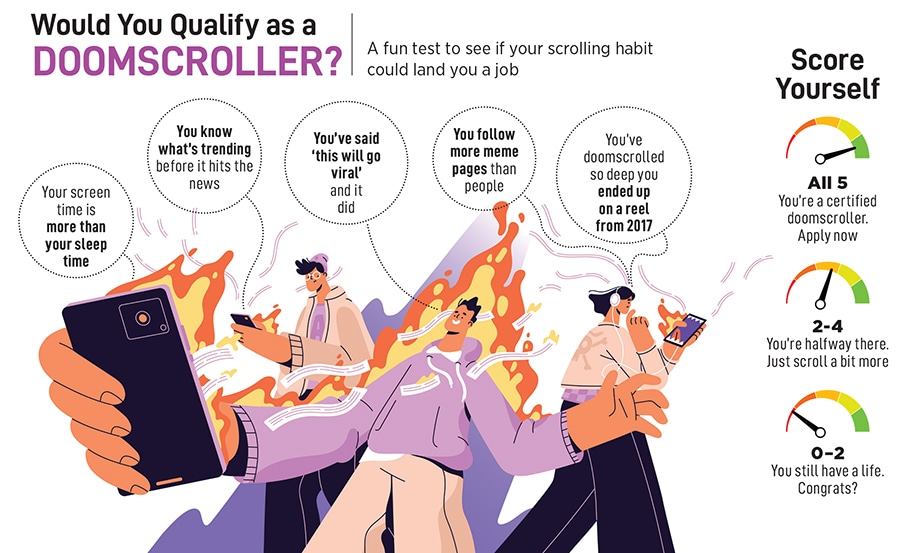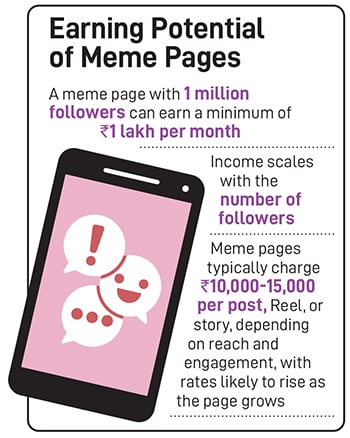Doomscrollers, meme-makers and the future of work
From meme creators to doomscrollers, a new generation of unusual jobs is transforming India's hiring landscape. These jobs combine creativity, culture, and online instincts to get brands ahead of the


Ranjeet Singh Lodhi makes memes for a living. He has been doing it for the past decade. What started as a fun activity in 2014—alongside pursuing engineering—has today led Lodhi to build a life for himself. It helped him buy a phone, a car, build a house, and provide for his family. As companies look for new-age roles like meme-makers and doomscrollers, the demand for people like Lodhi is only growing.
Earlier, stable professions like engineering, medicine or law dominated. Then came creative jobs like writing and photography, followed by social media managers and influencers. Now, it’s the turn of doomscrollers, meme-makers, and trend spotters.
A doomscroller is a digital trend hunter who gets paid to endlessly scroll social media to spot emerging content, viral formats and cultural shifts. A meme-maker, on the other hand, crafts humorous and relatable memes to engage audiences and amplify brand messaging. According to a June report by Equentis, an equity advisory firm, meme marketing will be a ₹3,000 crore industry by 2025.
A month ago, Viraj Sheth, co-founder and CEO of Monk-E, a media and artist management company, posted on LinkedIn that he was hiring doomscrollers. Around the same time, Kiran Shah, founder of Go Zero, was looking for a “Serial Meme-ster”. Earlier, Shah had sought someone to scout social media trends and create content ideas for his dessert brand.
This is not just an Indian phenomenon. Globally too, companies are hiring people who can boost their social media presence, attract followers and create buzz. For instance, Amanda Keaton, director of content and community at the US-based Very Special Games, posted three months ago seeking a doomscroller who could create content and grow the brand’s following.
Sheth says his creative team was already tracking online trends, but the process was “messy”. “The doomscroller role was created to convert endless scrolling into structured insight. It helps us catch emerging trends before they peak and use them in our content,” he says.

Sheth received thousands of applications within hours—from creators, strategists, psychologists and even engineers. Some applicants spent over 10 hours online daily. “We spoke with 15 people. Every conversation felt like a different version of the internet. Some treated it like a creative research role, others like cultural anthropology,” he says. The company has shortlisted four candidates for the final round.
For Monk-E, doomscrollers act as a cultural radar—linking creative, talent and sales teams to what’s happening online in real time. “Whether it’s a meme, a new creator or a sudden shift in tone, we want to act on it before everyone else does,” adds Sheth. Simply put, doomscrollers spot trends fast, giving content teams a first-mover advantage.
Go Zero’s Shah says hiring a “Serial Meme-ster” was both spontaneous and strategic. “Memes are the language of the internet,” he says. “You don’t hire a meme-maker for ‘fun posts’. You hire one to keep your brand alive in the cultural conversation.” He believes memes are not about visibility but relatability—they create a sense of community and brand loyalty. For instance, while Gemini’s saree photo trend went viral, Go Zero joined in by turning its ice cream flavours into saree-clad scoops on Instagram significantly boosting their online engagement.
Sheth believes Gen Z’s instinct for tone, humour and timing is unmatched. According to him, in today’s age, traditional experience matters less than how deeply someone understands online behaviour.
While founders like Sheth and Shah are hiring meme makers and doomscrollers, these roles have yet to enter the mainstream job market. According to Kamal Karanth, co-founder of staffing firm Xpheno, meme marketing is mostly treated as part of digital marketing services in media and communication firms, integrated into social media marketing. The skills required—content creation, visual design and copywriting—are closely aligned with existing capabilities in these teams.
Currently, there is no distinct demand for meme marketing roles. Similarly, doomscrolling is bundled into social media management and analyst positions, and has not evolved into a standalone skill set for full-time hires.
However, social media roles have gained prominence in digital branding, content and marketing over the past five years. “The current count of active talent in social media-specific roles is a little over 305,000 and this pool has annually grown by 8 to 12 percent over the last five years,” Karanth says.

Lodhi, 27, works out of his villa in Lonavala, built from his meme-making income. He runs the Instagram page Adultgram, which he started in 2014 under the guidance of his brother Avdhesh. “He introduced me to this industry, and I took it further to the next level,” he says.
With 5.1 million followers, Adultgram makes memes around trending topics in India and globally. “We make memes that inform and entertain. We convert news into memes to spread smiles,” says Lodhi. The page also collaborates with brands like Netflix India, Amazon Prime, Jio Hotstar, Zomato, Samsung and Flipkart for launches and promotions. Lodhi earns through sponsored posts, shoutouts and brand promotions.
To balance brand deals with content authenticity, Lodhi carefully vets agency pitches and verifies shared information to keep promotions genuine. “We avoid false news and use only trusted sources to prevent shadow bans. However, we can’t guarantee 100 percent accuracy as our news comes from multiple platforms,” he explains.
Lodhi relies on digital marketing agencies for work and has hired a content creator who helps with editing and design. Together, they maintain a library of meme templates for quick turnaround. “We just fit the right topic into the right template and a meme is ready,” he says.
Also Read: AI is changing the rules of recruitment
Beyond memes and scrolling, several quirky roles are emerging—trend analysts who decode online culture and digital vibe curators who shape a brand’s social personality. These jobs blend creativity, tech and instinct, becoming essential in today’s attention economy.
A 2025 study titled ‘Humor Sells: How India’s Meme Economy is Disrupting Digital Brand Strategy; in the International Journal for Multidisciplinary Research analyses over 100 campaigns by brands like Zomato, Netflix India and Fevicol. It shows how memes have evolved from gimmicks to a core “grammar” of digital branding, driving emotional connect and engagement among Gen Z and millennials.
Take Utkarsh Thakkar and Chitra Sharma for example. Mumbai-based Thakkar calls himself a “Vimanspotter”. His love for airplanes made him start an Instagram page in 2015 to share pictures. Regular posting got him noticed by GoAir, which later offered him to create aviation-themed content for its social media. “My role was to make sure every piece of content reflected the spirit of flying and felt authentic to the aviation world,” says the 30-year-old, who completed his stint with the airline after the pandemic and joined his family business.
Sharma, 27, from Delhi landed a copywriting job at a Mumbai-based advertising agency Only Much Louder after one of her viral X posts was noticed by her future employer. “During the pandemic I got active on X, posting one-liners and memes around work, relationships, etc,” she says. “People liked the posts and I somehow got a lot of engagement.” Her employer saw the virality of her content and hired her as a writer for the agency.
Industry experts believe roles like doomscrollers and memesters are early forms of trend intelligence jobs. As content becomes faster and more platform-specific, companies will need people who understand how ideas spread online. “What sounds quirky today will soon become a formal function inside creative teams,” says Monk-E’s Sheth says.
Shah agrees, citing how creators once sacked as hobbyists now shape marketing. “Meme-makers, doomscrollers and trend-hunters are modern sensors. They pick up what’s brewing before anyone else,” he says.
New roles such as AI prompt writers, trend forecasters and creators training algorithms to mimic tone and personality are also emerging. “The future belongs to those who can blend culture with code,” says Sheth.
For Shah, branding today is about retention, not just attention. “Everyone’s fighting for three seconds of scroll time. Memes and reels are tools—but tone is what keeps you relevant. If you can’t speak the internet, you’re behind,” he says.
These internet-native roles come with challenges—unstable trends, unclear career paths and intense competition. With undefined roles, inconsistent pay and constant pressure to stay relevant, burnout has become a real risk.
In a fast-paced news cycle, humour has become a way to make information engaging and relatable. Brands are realising the power of memes in marketing—cost-effective, viral and deeply cultural. “Meme marketing is the best way to reach the youth at scale and at affordable costs,” says Lodhi.
First Published: Nov 06, 2025, 17:22
Subscribe Now